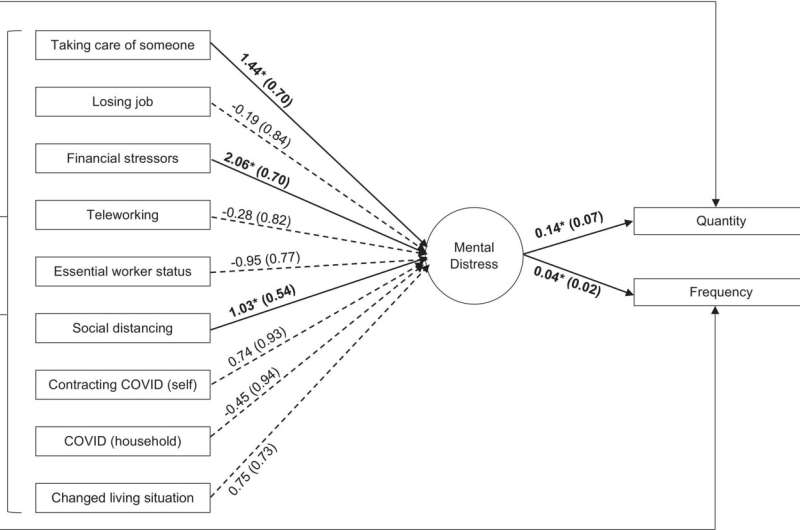This article has been reviewed according to Science X's editorial process and policies. Editors have highlighted the following attributes while ensuring the content's credibility:
fact-checked
trusted source
proofread
Stressors linked to increased drinking college students during COVID pandemic differ by race

College students reporting increased mental distress during the pandemic also reported greater quantity and frequency of alcohol use, and distress was linked to certain pandemic-related factors which differed by race.
A study published in Alcohol: Clinical and Experimental Research identified social distancing as a stressor linked with mental distress for both Black and white college students, whereas financial issues were associated with mental distress in white students, and contracting COVID-19 was linked to mental distress in Black students.
The study examined whether mental distress may be a link between pandemic-specific stressors and student drinking behaviors and whether that link differs by race. Researchers surveyed four hundred college students from October to December 2020 about whether they experienced any of the nine pandemic-related stressors.
They were also asked about changes in drinking quantity and frequency and assessed for symptoms of stress, anxiety, depression, and alcohol use over the past month.
Half of the participants experienced financial stressors. Twenty to 30 percent reported each of five other factors due to the pandemic: job loss, taking care of someone, change to telework, being an essential worker, or a changed living situation. Overall, taking care of someone, financial stressors, and social distancing were associated with increased mental distress. In turn, mental distress was linked to increased quantity and frequency of drinking.
Regardless of mental distress levels, students experiencing financial stressors were more likely to drink more and more often than they did pre-pandemic. Participants who started teleworking were more likely to report an increased quantity of drinking; participants taking care of someone drank more often.
When examining differences across races, Black participants reported greater mental distress than white participants. Financial stressors were linked to greater mental distress among white students but not for Black students.
For Black participants, being an essential worker was associated with lower levels of mental distress, while contracting COVID-19 was associated with greater mental distress; neither factor was significantly associated with mental distress for white participants. Social distancing was linked to greater mental distress for all students. Researchers found no significant differences between Black and white students in perceived changes in the quantity and frequency of drinking.
Compared to their drinking patterns before the pandemic, about half of the participants reported no changes in the quantity or frequency of their drinking; twenty-seven percent reported drinking greater quantity, and 34 percent reported drinking more often. Black students reported drinking alcohol less frequently and in significantly lower quantities than white students.
Researchers recommend university efforts to connect students with campus mental health services, which tend to be used by 10 percent of students, with Asian, Black, and Latinx students utilizing care at lower rates than white students.
This cross-sectional mediation analysis does not imply causality and did not examine other factors that may have contributed to mental distress. Forty-three percent of participants were white, and 28 percent were Black; three-quarters were cisgender women.
More information: Abby L. Braitman et al, The impact of the COVID‐19 pandemic experiences on college drinking via mental distress: Cross‐sectional mediation moderated by race, Alcohol: Clinical and Experimental Research (2023). DOI: 10.1111/acer.15200




















